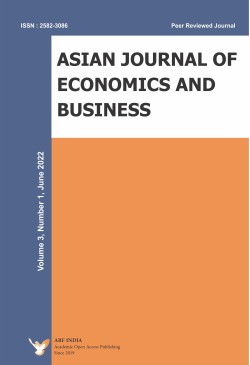
Asian Journal of Economics and Business
Frequency :Bi-Annual
ISSN :2582-3086
Peer Reviewed Journal
This research aims at designing a proposed model for employing social media in achieving the objectives of sustainable development through this proposed model. The researchers used the descriptive and analytical approach to survey and analyse the previous literature to infer the results of this research.In addition, this qualitative analysis was conducted to interpret the ideas and results of partial and quantitative research related to this research to support the information collected and thus design the study model. Findings revealed that the ability of social communication in achieving the objectives of sustainable development is still limited and restricted to traditional uses. Hence, the aim of this proposed model is to optimize the employment of social media in achieving the goals of sustainable development based on the researchers’ vision.
Keywords: Arab region, proposed model,social media, sustainable development.
The origins of creativity were not as many assumed beginning ten years ago, but instead over one hundred thousand years ago basically during the Paleolithic age. According to Wilson (2018), the origins of the concept of creativity illustrates the way by which humanities, spurred on by the language’s invention, while played a major role in the process of defining our species. Creativity is still attracting our attention, while at the same time making us figure out what are the benefits beyond it and what the challenges may be faced to promote it, in particular during education stage.
This research paper articulates an in-depth study on the implications of innovation and creativity in improving student’s achievements, basically in primary levels. Problem statement, question of the research, aims and objectives, methods and methodology will be stated in the following chapters. The main concern of this study is figuring out whether we can support or not, the idea that creativity & innovation help student in their academic achievement.
Keywords: Innovation & Creativity – Education –Higher Education - Students - Teachers – Academic Achievement – Qualitative Research – Interviews – Education Methods – Barriers – Critical Thinking – Students Empowerment
As stated above, the research used Coca Cola company benefits and compensation practices to understand how companies currently carry out their remuneration and rewards programs. Initially, we analyzed the company profile, the HR department and the administration to understand how the company functioned. Several employees were interviewed and their responses are documented in this report. The collected information was then analyzed to make the necessary recommendations also documented in this report.
In the current world, companies find it hard to retain talented workers for the purpose of sustaining and improving their productivity and growth. Companies lose employees to other businesses, particularly to competitors who provide them more attractive packages. The current economic situation is playing a huge role in making the companies realize that this trend is affecting their businesses in major ways. Thus, there is dire need for companies to formulate new strategies that will help them retain most of their talented workers to enhance their productivity. To this end, the human resource departments of any company have to conduct extensive research to understand the nature of any strategy used in these endeavors. The strategies have to motivate employees in order to maximize their productivity and retain them within the company.
First, the study aims to understand the compensation and benefits programs of Coca Cola Company. Second, it also seeks to know Coca Cola company’s worker satisfaction levels given the current organizational benefits and compensation programs. Last, the study seeks to provide recommendations relating to employee motivation using benefit and compensation packages.
Keywords: compensation practice; formulate new strategies; enhance productivity; motivation
The fourth largest food crop of the world in terms of the production (after rice, wheat and maize) is potato. It is also a good source of nutrients, minerals and vitamins and carry very low amount of calories. An average potato consists of 80% water and 20% solid matter. Potato is known by different names in different nations. In Spain it is called ‘Patata’, in France it is termed as ‘Pomme de terre’ in Netherland, it is known by ‘aardappel’. In India Potato is called mostly by ‘alu’ or ‘aloo’, in Gujarati it is called ‘bataka’. At present China and India together produces nearly 40% of the world’s total potatoes. This paper tries to through some lights on the cost of production, price and marketing channels of potato in Jalpaiguri Sadar Block. This paper is based on both primary and secondary data. Primary data is collected through convenience sampling. The secondary information is collected through office of the Agriculture, Jalpaiguri, and Statistical Hand book of Jalpaiguri district. Regarding methodology simple table, chart, SAGR Simple Average Growth rate, CAGR Cumulative Average Growth Rate, ANOVA, Turkey’s multiple comparison method, Correlation matrix etc techniques are applied in this study.
Keywords: Potato, Jalpaiguri, Cold storage, Jyoti, Holand alu
JEL Classification numbers: G00, G390, C83
Based on an extended Mundell-Fleming Model, this study finds that fiscal expansionreduces outputand causes the Indonesian rupiah to appreciate whereas monetary expansionraises output and causes the Indonesian rupiah to depreciate. Hence, except for the effect of fiscal expansion on output, the predictions of the Mundell-Fleming model apply to Indonesia.
Keywords: Mundell-Fleming model, fiscal policy, monetary policy, exchange rates, stock prices
JEL Codes: E52, E62, F41
Applying an extended Mundell-Fleming model to Chile, this paper finds that fiscal expansion reduces output but causes real appreciation and that monetary expansion increases output and leads to real depreciation. Besides, a lower real interest rate or a higher real stock price helps raise output; and a higher real interest rate or a higher real stock price results in real appreciation. Hence, except for the negative impact of fiscal expansion on output, other predictions of the Mundell-Fleming model are applicable to Chile.
Keywords: fiscal expansion, monetary expansion, exchange rates, Mundell-Fleming model.
JEL Codes: E52, E62, F41